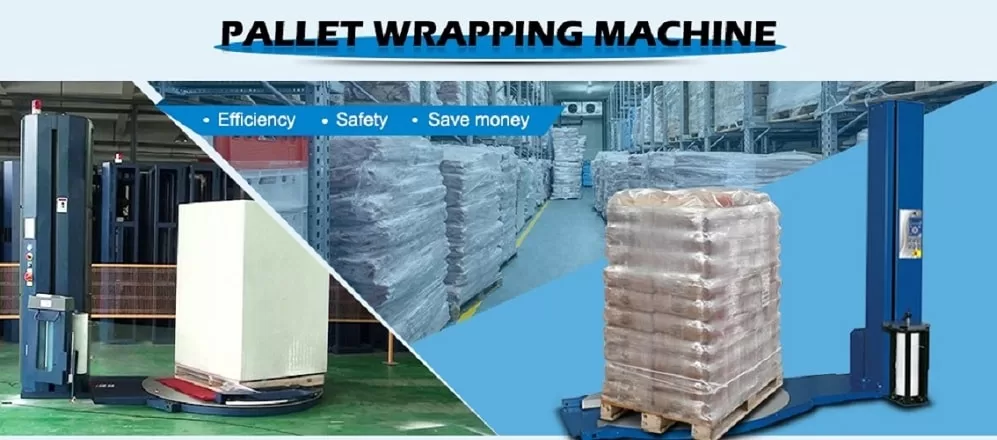Understanding Automatic Pallet Stretch Wrapping Machines with Integrated Film Cutters
Automated packaging solutions are essential for streamlining end-of-line operations in manufacturing and distribution. Among these, the automatic pallet stretch wrapping machine with an integrated film cutter stands out for its ability to enhance efficiency, improve load security, and reduce manual labor. This article delves into the operation, features, and benefits of these critical systems.
What is an Automatic Pallet Stretch Wrapper with Film Cutter?
An automatic pallet stretch wrapping machine equipped with a film cutter is an advanced packaging system designed to unitize pallet loads using stretch wrap film without direct operator intervention during the cycle. Key components typically include:
- Turntable or Rotary Arm: The mechanism that creates relative motion between the pallet load and the film dispenser. Turntable models rotate the load, while rotary arm models move the film dispenser around a stationary load.
- Film Carriage System: Holds the roll of stretch film and applies it to the load. Advanced systems feature powered pre-stretch capabilities, stretching the film before application to maximize yield and improve load containment.
- Control System: Usually PLC-based with an HMI (Human-Machine Interface), allowing users to program various wrap parameters (e.g., rotation speed, number of top/bottom wraps, film tension, overlap).
- Automatic Film Cut and Clamp System: This mechanism automatically cuts the stretch film at the end of the wrap cycle and typically clamps the leading edge for the start of the next cycle or wipes the film tail against the load.

pallet How the Wrapping Process Works
The typical operational sequence for an automatic pallet stretch wrapper with a film cutter involves:
- Pallet Infeed: The palletized load is conveyed or placed onto the wrapping zone (turntable or designated floor space for rotary arm models).
- Cycle Start: The machine, often triggered by sensors detecting the pallet's presence, initiates the wrap cycle based on pre-programmed parameters.
- Film Application: The film carriage dispenses the stretch film, often utilizing pre-stretch rollers to elongate the film (commonly 150% to 300%). The turntable rotates (or the rotary arm orbits), applying the film in a spiral pattern up and down the load according to the programmed wrap recipe. Load height is typically detected automatically.
- Film Cutting and Securing: Upon completion of the programmed wraps, the automatic film cut and clamp system activates. It cleanly cuts the film and secures the tail, often by wiping it against the load or using a heat seal mechanism.
- Pallet Outfeed: The wrapped pallet is then automatically conveyed out of the wrapping zone, making the machine ready for the next load.
The Significance of the Automatic Film Cutter
The integration of an automatic film cutter is a crucial feature distinguishing fully automatic stretch wrappers. Its primary advantages include:
- Elimination of Manual Cutting: Frees operators from needing to manually cut the film after each cycle, significantly reducing labor requirements and improving workflow.
- Enhanced Safety: Removes the need for operators to approach the moving machinery or use manual cutting tools near the wrapped load, reducing the risk of accidents.
- Increased Throughput: Speeds up the overall cycle time by automating the final step, allowing for more pallets to be wrapped per hour.
- Consistent Finish: Ensures a neat, reliable cut and secure film tail on every load, contributing to better load integrity and appearance.
Key Features and Capabilities
Modern automatic stretch wrappers offer a range of sophisticated features:
- Programmable Wrap Parameters: Allows customization for different load types, sizes, and stability requirements. Settings often include top/bottom wrap counts, carriage speed (up/down), turntable/arm rotation speed, film tension, and pre-stretch ratio.
- Powered Film Pre-Stretch: Dramatically reduces film consumption compared to no-pre-stretch or basic mechanical stretch systems, leading to significant cost savings and stronger load containment.
- Load Height Sensing: Automatically detects the top of the load using photo-eyes or similar sensors, ensuring complete wrapping without wasted film or time.
- Advanced Safety Features: Often include safety fencing, light curtains, emergency stop buttons, and sensors to detect obstructions, complying with industry safety standards.
- Variable Speed Control: Allows adjustment of rotation and carriage speeds to accommodate unstable or light loads.
Benefits in Industrial Applications
Implementing an automatic pallet stretch wrapping machine with a film cutter provides substantial operational advantages:
- Increased Efficiency and Throughput: Automation minimizes manual intervention and speeds up the wrapping process, boosting overall packaging line productivity.
- Improved Load Containment and Stability: Consistent film application, tension control, and pre-stretching ensure pallets are securely wrapped, reducing product damage during transit and storage.
- Reduced Labor Costs: Automating the wrapping and cutting process allows personnel to be reassigned to more value-added tasks.
- Optimized Material Usage: Powered pre-stretch systems maximize the yield from each roll of stretch film, cutting down on consumable costs and environmental impact.
- Enhanced Workplace Safety: Automating the cutting process removes a potentially hazardous manual task.
- Consistent Product Protection: Provides a reliable barrier against dust, moisture, and potential tampering during shipping and handling.

pallet stretch wrap 4 Conclusion
Automatic pallet stretch wrapping machines with integrated film cutters represent a significant advancement in end-of-line packaging technology. By automating the entire wrapping and cutting process, these systems deliver enhanced efficiency, superior load security, reduced operational costs, and improved safety compared to manual or semi-automatic methods. For businesses handling significant pallet volumes, investing in this technology is a key step towards optimizing logistics and protecting valuable goods throughout the supply chain.
